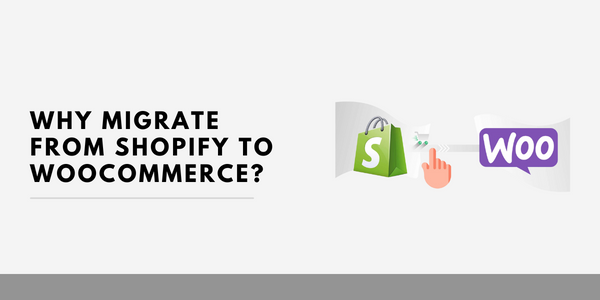Why You Should Migrate Shopify to WooCommerce
 Mike Micheal
06 Dec, 2024
6 mins read
95
Mike Micheal
06 Dec, 2024
6 mins read
95

As the e-commerce landscape evolves, choosing the right platform for your online store is crucial. Many businesses initially launch on Shopify due to its simplicity but later discover the flexibility and customization power of WooCommerce. If you're considering a switch, this guide explains why migrating from Shopify to WooCommerce could be the best decision for your business.
What Is WooCommerce?
WooCommerce is a highly customizable e-commerce plugin for WordPress, powering millions of online stores worldwide. Unlike Shopify, which is a closed ecosystem, WooCommerce is open-source, offering greater flexibility and ownership over your store.
Whether you're a small business owner or managing a large enterprise, WooCommerce adapts to your specific needs, making it an ideal platform for long-term growth.
Key Reasons to Migrate Shopify to WooCommerce
1. Greater Customization Options
Shopify’s streamlined structure is great for beginners but comes with limitations in design and functionality. WooCommerce provides unparalleled flexibility, allowing you to:
- Modify every aspect of your store’s layout.
- Use thousands of free and premium themes.
- Add custom plugins to enhance features.
With WooCommerce, your store can truly reflect your brand’s identity.
2. Cost-Effectiveness
Shopify’s pricing model includes monthly fees for the platform, add-ons, and transaction fees. WooCommerce, on the other hand, is free to use. You only pay for hosting, domain names, and any premium extensions you may choose.
By switching to WooCommerce, businesses often save on recurring costs, especially as they scale.
3. Ownership and Control
With Shopify, your store’s data and functionality are tied to the platform. If you decide to leave, transferring your data can be a challenge.
WooCommerce, being open-source, gives you full control over:
- Your store data.
- Customizations and third-party integrations.
- Future scalability and platform independence.
This autonomy ensures long-term stability and flexibility for your business.
4. Expansive Plugin Ecosystem
WooCommerce offers access to a vast library of plugins, covering everything from SEO optimization to advanced payment gateways. These plugins enable you to:
- Add multilingual capabilities.
- Improve your SEO performance.
- Customize checkout flows and shipping methods.
Shopify’s app store is robust but often requires additional fees, making WooCommerce a cost-effective choice.
5. SEO and Content Marketing Advantage
WooCommerce operates on WordPress, the world’s leading content management system. This gives you:
- Advanced SEO tools for optimizing product pages and blogs.
- Better control over site speed and performance.
- Seamless content marketing opportunities to attract organic traffic.
Shopify’s SEO features are limited in comparison, making it harder to rank for competitive keywords.
Challenges During Migration and How to Overcome Them
While the migration process is relatively straightforward, you may encounter a few challenges:
1. Data Compatibility
Not all Shopify data fields align perfectly with WooCommerce. Use the migration plugin to ensure proper mapping, or consult a professional if needed.
2. SEO Preservation
Switching platforms can impact your SEO rankings. Mitigate this by:
- Setting up 301 redirects for old Shopify URLs.
- Using WooCommerce SEO plugins like Yoast SEO.
3. Learning Curve
WooCommerce offers more features, which can feel overwhelming initially. Spend time familiarizing yourself with the platform or hire a WooCommerce expert for a smoother transition.
Benefits of Migrating to WooCommerce
1. Increased Scalability
WooCommerce grows with your business. Whether you’re expanding product lines or targeting global markets, WooCommerce provides the flexibility to scale effortlessly.
2. Advanced Analytics
With WooCommerce, you gain access to powerful analytics tools to track sales performance, customer behavior, and marketing ROI.
3. Tailored Customer Experience
Customize your store’s design, product recommendations, and checkout flow to offer a unique and engaging shopping experience.
4. Integration with WordPress
Leverage WordPress’s vast ecosystem of plugins and tools for blogging, email marketing, and lead generation.
5. No Platform Lock-In
Unlike Shopify, WooCommerce doesn’t lock you into its ecosystem. You have full ownership of your store and can switch hosting providers if needed.
Conclusion
Migrating from Shopify to WooCommerce is a strategic move for businesses looking to gain greater control, flexibility, and cost savings. With WooCommerce, you can create a highly customized and scalable store tailored to your unique needs.
If you’re ready to make the switch, tools like the Shopify to WooCommerce migration plugin simplify the process, ensuring a smooth transition with minimal disruption to your business.
Written By:
Mike Micheal



Hotels at your convenience
Now choose your stay according to your preference. From finding a place for your dream destination or a mere weekend getaway to business accommodations or brief stay, we have got you covered. Explore hotels as per your mood.





